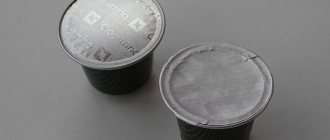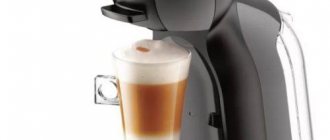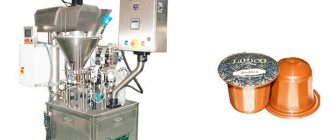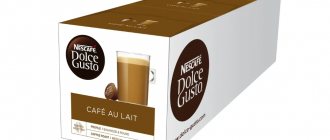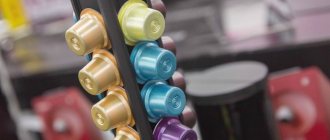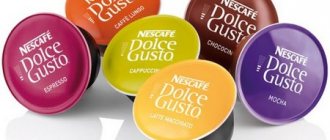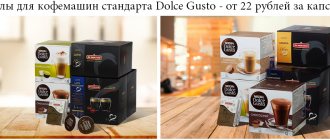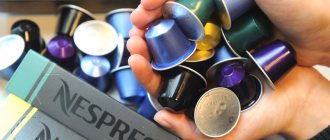These products, generally speaking, are disposable and are not intended for reuse. However, if you are wondering how to refill a capsule for a coffee machine, then you guess that such a limitation can be circumvented. This move will allow you not only to save several times on the coffee itself, but also, what is much more important, to try the flavors of your favorite drink that are not produced by the manufacturer of the coffee maker you purchased.
Attention! Using incorrectly filled capsules, as well as capsules that are not intended for your machine, can lead to failure of the coffee machine!
Types of capsules for coffee machines
Today, each manufacturer has developed unique capsules for their own coffee machines. Despite their formal incompatibility, the container designs are not fundamentally different:
— capsules for Nepresso coffee machine
— capsules for Lavazza coffee machines
— capsules for Nescafe Dolce Gusto coffee machines
— capsules for coffee machines
— capsules for Espresso coffee machines
Before refilling a capsule for a coffee machine, you should learn a little about the structure of such containers. There is nothing complicated here: inside the plastic cup there are two membranes that protect the coffee between them from moisture and other negative influences.
Experiment with capsules
How a Muscovite competes with corporations in the coffee market
Anton Akifiev was the first in Russia to establish the production of capsule coffee. This is a marginal business, but it turned out that the sale of beans of their own roasting gives great turnover. In 2016, the entrepreneur sold coffee for 60 million rubles.
Founder of Brill Café Anton Akifiev (Photo: Vladislav Shatilo / RBC)
“George Clooney is largely to blame for the popularity of capsule coffee in Russia,” says Anton Akifiev, founder of the Brill Café coffee brand. “Without Nespresso commercials with his star participation, people would still perceive capsules as chemicals, additives - anything, but not coffee.”
In 2011, Akifiev was the first in Russia to produce capsule coffee. But it was not possible to immediately take away any noticeable part of the market from the international corporations Nestle and Lavazza. For three years, the company made losses, until the market collapsed, and customers began to look for cheaper options.
Brill Café capsules cost on average 25% less than their imported counterparts. As the coffee business developed, it became clear that more significant turnover (though with a smaller margin) was achieved by trading in own-roasted coffee beans. In 2016, wholesale trade in capsule and roasted coffee brought the group of companies about 60 million rubles. revenue and 7 million rubles. arrived. And most importantly, the Russian manufacturer was finally noticed by retail - the company entered into contracts with X5 Retail Group and Metro Cash & Carry.
Capsule format
Coffee capsules were invented by Nestle employee Eric Favre. His bosses liked the development so much that in 1986, the Nestle Group registered a separate company called Nespresso. In the same year, Nespresso launched its first coffee machine on the market, and later the company registered another brand, Nescafe Dolce Gusto. All developments were protected by patents, but very quickly Nestle had followers like the Italian company Lavazza, the American Mondelez, who sold modified capsules and coffee machines for them. And in 2012, most of Nespresso’s patents expired and many people began producing capsules for Nespresso machines. The fashion for capsules came to Russia in 2009–2010, when Nespresso began to be actively advertised on television.
“The right cup of coffee is an art. For example, real espresso perfecto is 25–30 ml of drink, obtained from exactly 7 g of ground coffee during 25–30 seconds of brewing, and nothing else,” says Anton Akifev. “It is almost impossible for an average person without special knowledge and experience to achieve such accuracy, and the capsules contain a ready-made mixture of ingredients, the proportions of which are verified by production technologists.” Unlike ground coffee, which after opening the pack retains its taste for no more than a month, sealed capsules can be stored for a year and a half.
The main disadvantage of capsule coffee is its high price. A capsule for “Espresso” retails for 25–35 rubles, and the cost of a serving of regular bean coffee for one cup is 5–8 rubles.
Students and fast food
After graduating from the Faculty of Economics of Moscow State University, Anton Akifiev worked as a brand manager at the Russian representative office of North Winds Brewing Corp, where he promoted the Foster's, Edelweiss and Kirin beer brands. When Nord Winds acquired the winery), Akifiev took over as marketing director there. But the holding’s new business did not last long: in 2006, the chief sanitary doctor of the Russian Federation, Gennady Onishchenko, banned the import of Moldovan wines into Russia. “The company ceased to exist one day,” recalls Akifiev. However, by that time Akifiev was already fully engaged in the coffee business.
Back in 2002, Anton, together with his school friend Yaroslav Kulev, registered Widger LLC and bought a Samsung coffee machine for $2 thousand, which he installed in one of the Moscow universities. On the first day of operation, the machine sold more than 80 cups of coffee. Six months later, Akifiev already owned 16 devices, which were, as a rule, located in educational institutions: students turned out to be a profitable target audience. The main problem of this business is the high costs of purchasing machines . The entrepreneurs had no money, but wanted to scale the business.
In 2004, Akifev signed a three-year contract with Nestle. The corporation provided branded machines and Nescafe coffee, and the entrepreneur negotiated with the owners of offices, cafes, and gas stations about their installation and provided maintenance. Property owners bought coffee for 8–10 rubles. per cup (Widger also had its share of this amount), and then they sold it to clients or employees for 70 rubles.
The entrepreneur also began collaborating with the Italian bean coffee manufacturer Caffe Mauro - this coffee, unlike Nescafe products, was no longer suitable only for fast food, but also for expensive restaurants. To do this, I had to register a new one, because... the terms of the contract with Nestle did not allow us to work with other partners on behalf of the same legal entity.
Made in Tula
The idea of roasting coffee yourself and packaging it in capsules appeared during the 2008 crisis. “I felt a trend - thanks to the crisis, own production in Russia was supposed to become a profitable business,” says Anton.
The entrepreneur decided to ride the growing wave of import substitution and create a domestic analogue of the famous Nespresso. He invited his partner Yaroslav Kulev to invest in production, but he refused. The partners divided the business and sold some of the devices.
To test demand, Akifyev purchased about 700 machines with capsules from the Italian company Binotti, spending 1.4 million rubles on it. They managed to sell them in Moscow in three months, earning about 2 million rubles. It became clear that there was demand. In 2011, Akifiev found a new partner who supported the idea of producing capsules. According to SPARK, 26% of Rico Distribution is owned by Renat Aisin.
Together co-owners for 3 million rubles. bought a building with an area of 550 sq. m and an adjacent plot of 24 acres in the village of Pervomaisky, Tula region. The former head of the Tula branch of Vidzhera, Sergei Trofimov (now the head of production of Brill Café, Akifev’s brand), who lived in the village and often rode past the dilapidated building on a bicycle, helped with the search for premises. “This building was built by captured Germans after the war. They built it well, the foundation, the walls - everything was standing, only the roof was missing. Birch trees grew inside the building,” recalls Akifiev. According to him, the renovation of the building cost 5 million rubles. — we had to remove 18 dump trucks of garbage, re-install communications, and fill the floor. The partners spent 23.4 million rubles on the entire process of launching production.
They buy coffee in European ports, where ships with containers from Ethiopia, Kenya, Brazil, etc. arrive. They decided to roast the beans themselves: this allowed them to follow the technology from start to finish and at the same time save money - there is no import duty on green coffee, unlike roasted coffee.
The roasted coffee was packed into capsules by an Italian capsule machine: it sucks up the beans with a special “vacuum cleaner”, grinds them and packs them into 7 g packages, and the nitrogen plant pumps oxygen out of the capsule. Technologists monitor the quality. “One day they decided to show off: they experimented with the process, and, in our opinion, the coffee turned out tastier than usual. But this batch of several tons was returned to us: people get used to one taste, and if a cup of coffee suddenly becomes different, it means it has become worse,” says Anton.
Brill Café first ordered the capsule molds, film and filter paper from the Italian company Carte Dozio. And in 2015, a small plastic products manufacturing plant from Chelyabinsk approached Akifyev with an offer to sell capsules of the same quality at 20% cheaper. “At first we were distrustful - the mold itself for making capsules costs $25 thousand, but then the local Kulibins themselves developed this mold,” says Anton. “But the quality pleasantly surprised us.” Now Brill Café continues to work with the Chelyabinsk plant, saving 300-400 thousand rubles on the purchase of capsules. per month.
Founder of Brill Café Anton Akifiev (Photo: Vladislav Shatilo / RBC)
Saving grain
It was difficult with clients at the first stage, Akifiev admits. “Convincing people that it’s possible to produce decent coffee in Russia at all is not an easy task,” he says. They planned to sell the finished capsules to manufacturers and distributors of coffee machines, but entrepreneurs are not as fond of experiments as ordinary consumers.
The capsule coffee market is divided into several formats based on types of coffee machines. The most popular is the format for Nespresso coffee machines (65% of the market) and Dolce Gusto (15% of the market), says Vyacheslav Timashkov, co-owner of the company producing coffee capsules Single Cup Coffee, one of Akifiev’s followers. Brill Café produces capsules in the Lavazza Espresso Point (LEP) format. Such capsules occupy, according to company estimates, about 15–20% of the market.
At the time of production launch in 2011, the Nespresso format was still protected by a patent, and releasing capsules for this format would have been a violation of the law. Therefore, Akifiev chose a narrower niche. He managed to come to an agreement with Russian distributors of Italian Lavazza coffee machines in the regions - Smolensk, Yaroslavl, Yekaterinburg, Sergiev Posad.
But LEP's market niche was small. After a year and a half, capsule production still hasn’t brought Brill Café into profit. Akifiev decided to expand the range. “We still roasted the beans in our own production and came to the logical idea to create another line,” explains Anton. Now, after roasting, some of the beans were immediately used for packaging and sale, while some were still packed into capsules. Brill Café sold bean coffee to restaurants and cafes; connections were established back in the days when Akifiev was servicing coffee machines.
In 2015, Brill Café accidentally expanded beyond Russia. Nikolai Rodler, a Russian emigrant living in Cologne, became the company's distributor in Germany. Akifiev met him through a mutual friend. Now Russian capsules "Brill Café" can be found in several fast food restaurants in Cologne. They are cheaper than from local suppliers. The company plans to look for new representatives in European countries and China. “China is generally a tasty morsel now,” says Akifiev. — There are 1.5 billion Chinese people—a huge market. And all these one and a half billion begin to actively drink coffee, whiskey, beer, and smoke cigarettes - thanks to Western trends. The coffee market is doubling in China every year.”
The first three years of operation were unprofitable for the company; production reached zero only in 2014, and in 2015 they managed to earn their first profit - 7 million rubles. Now about 60% of all coffee produced is sold wholesale to distributors, 30% - direct sales to restaurants, 10% - retail sales through online coffee stores. This structure has so far lacked an important element—sales through retail chains. But now it is appearing, and the emphasis is not on capsules, but on selling beans of their own roasting.
Sell directly
To increase sales volume, Akifiev decided to go into retail. He sent out commercial offers, but no one responded - the market had already been divided by Western corporations. Then the entrepreneur turned to the Ministry of Industry and Trade for help. “My partner and I just came to an appointment with the director of the consumer markets department, Denis Pak, and told our story - they say, Russian manufacturers want to join the flow of import substitution, but we can’t go online from the street,” recalls Akifiev. “He made two calls in front of us - to X5 and Metro, and within two weeks I met with representatives of both companies.”
Brill Café signed contracts with X5 Retail Group and Metro Cash & Carry in the fall of 2016. At X5, Akifiev plans to sell coffee by weight: on the counter in the sales area there will be 12 types of coffee in glass “pockets,” a coffee grinder and scales. The buyer will be able to choose the desired type and volume of coffee, weigh it, punch the barcode and take it to the checkout. The price for all varieties will be the same - 180–200 rubles. for 100 g. An agreement has been concluded with Rico Distribution LLC, confirms X5 Retail.
In the Metro network, which is aimed at small wholesalers, Brill Café will install a “vending corner.” Products necessary for vending machines will be sold there: cups, spoons, sugar packets and Brill Café coffee beans. Akifiev has high hopes for this cooperation: he expects to increase the revenue of the group of companies to 110 million rubles. based on the results of 2017.
Capsules now account for only 15% of Brill Café’s production volume, the rest being roasted beans. But the margin on capsules is twice as high. Akifiev does not lose hope of instilling in Russians a love for capsules. “The overall volume of coffee consumption in the country is growing: it’s fashionable, people take coffee with them, young people drink it. Regular coffee is already becoming something everyday, people are looking for new forms. And capsules, thanks to skillful advertising of our competitors, can become a new trend,” he is confident.
He is no longer alone. In addition to Brill Café, capsule coffee in Russia is now produced by a number of other brands: Live Coffee, Single Cup Coffee, Coffee Blues and Coffelover.
“Since May 2016, we have also been producing capsules, but we are working in the format of Nespesso machines, and therefore we do not overlap with Brill Café,” says Vyacheslav Timashkov from Single Cup Coffee. According to him, the Nespesso segment is the largest on the market, and besides, the original has become much more expensive due to the weakness of the ruble. At the same time, despite the growth in the number of Russian manufacturers, the overwhelming share of the capsule market is still occupied by Western players. “It takes time for buyers to trust domestic coffee,” says Timashkov.
How to refill a coffee machine capsule yourself
As mentioned, the differences between capsules from different manufacturers come down to shape and size. Therefore, having learned how to refill a capsule for a coffee machine of one brand, you will be able to cope with other machines.
Strictly speaking, it is not possible to refill a disposable capsule. More precisely, you can try to do this, but in practice such attempts are fraught with damage to the device. On the other hand, you can get even better results by making a reusable capsule with your own hands. There is nothing complicated about this, and it will only require a few minutes of time and two already used containers:
- Using a knife, cut off the bottom end of the capsule just above where the foil membrane is located (this can be discarded).
- Clean the inside of the container of any remaining coffee and dry it thoroughly. Be careful: there is another membrane in the capsule - it must be kept intact.
- Take the second capsule and cut it in the center area. Here the plastic is somewhat thicker and you can use scissors or other available tools to obtain an even cut line.
- Remove the membrane from the second capsule, clean it of coffee residues and dry it. As a result, you should have two parts of capsules, one of which can be put on the second.
- Pour the prepared coffee into the resulting structure and connect its two halves, lightly squeezing each other.
- Your reusable capsule is ready to use!
- Important! When using reconstituted capsules, it is necessary to accurately align the hole in the top with the needle, otherwise coffee may get into the mechanism of the device and clog it.
You can watch the whole process in action in the video on how to refill a capsule for a coffee machine:
Features of reusable capsules
Hermetically sealed empty “cups” with filters and lids included are made from food-grade plastic. These coffee containers have holes already made in the bottom and lid. All you have to do is fill the capsule with the type of coffee you want at the moment.
Nespresso reusable plastic capsules are compatible with Nespresso capsule machines. The coffee is poured in, the excess is removed and that’s it, the capsule is ready! The cup must be inserted into a special block of the coffee machine and press “start”.
You can put either one type of coffee or a mixture of different types of ground coffee into the capsule. Plus, by using Nespresso's refillable capsules, you can brew herbal green or black tea if you prefer. The fact is that food-grade plastic does not absorb odors and is quite easy to clean. Therefore, the next portion, prepared using a capsule that has already been in the coffee machine, will be aromatic and fresh.
Reusable capsules, which are produced in different countries of the world, come in the following types:
- Emohome (China);
- Coffeeduck and Douwe Egberts (Holland);
- Caffe Vergana (Switzerland, Germany, Italy, Spain, Portugal).
Nespresso standard reusable capsules
The existence of reusable capsules for self-filling coffee became known quite recently. Reusable capsules resemble the shape of the original capsules but only with an opening lid. After filling the capsule with coffee, you can tightly secure the capsule with a latch on the lid. However, this method also does not guarantee the safe use of the coffee machine, since reusable capsules are produced by third-party companies that are in no way connected with the manufacturers of capsule coffee machines.
For an example of using reusable coffee capsules, see the video:
Reusable capsules at Wildberries
Advantages and types of capsules
An airtight capsule with freshly roasted ground coffee ideally preserves its taste for up to a year or more. Slightly smaller than a walnut, these “jars” come in aluminum, plastic and a combination, and all of them are safe for health. It’s difficult to say which of them is better (opinions vary), but Nespresso and Orimi use aluminum capsules. By the way, this is one of Nestle's lost patents, so... go ahead!
learn more about suppliers of capsule cups
Feedback
Your message has been successfully sent
In addition to espresso capsules, manufacturers offer decaffeinated coffee and with additives (cappuccino, latte, flavored blends, etc.), as well as chocolate and cocoa. More recently, a promising tea capsule trend has emerged - for example, the startup Tpresso is actively developing in China under the leadership of the “parent” of capsules, Eric Favre. It is expected that these capsules for true tea connoisseurs will first gain a foothold in Asia, and only then will they move to Europe. While Tpresso is far away, Orimi is quickly capturing the Russian niche!
Let's calculate the “capsule” profit!
The margin on capsule drinks reaches 400%.
If we take the cost of an aluminum container as 3 rubles, and a kilogram of coffee and tea as 500 rubles (wholesalers' price), then a finished capsule with 5-9 grams of filler will cost the manufacturer about 6 rubles. Its retail price in Russia, due to the underdevelopment of the market, is high and amounts to about 25-30 rubles (we estimate the income!). In Europe, one capsule is sold for approximately the equivalent of 15 rubles, and even if our price eventually drops to the European price, the margin will remain good.
The benefit may lie not only in income, but also in brand image. Capsules are fashionable, cool, prestigious! Such products instantly elevate the brand into the premium segment.
So, the production of capsule coffee, tea and other drinks is:
- stable and extremely profitable business
- status of an “expensive” innovative company
- entering a half-empty niche (you won’t have to bump into your competitors!)
- minimum technological equipment
Coffee
To produce capsules, we use proprietary mixtures from group B+. This coffee is roasted quite dark and brews well in capsule coffee machines. The varieties were selected to suit different taste preferences: here you can find the rich Al Robusto, the creamy chocolate Prohibition, and the calm, nutty Cote Brasilio. We roast our coffee to our standard profiles and put it through a color sorter to get rid of the quakers. After roasting, the coffee is degassed for 7-10 days, only after which the production of capsules begins.
Single Cup Coffee range
Buyers are offered several coffee options, varying in degree of roasting, as well as delivery to various Russian regions, a list of pick-up points for Muscovites and residents of the Moscow region, and courier service. The new Russian company plans to expand the range of coffee, launch new series, and conduct experiments with combining varieties. The price of one package (10 capsules) is only 199 rubles.
Today, Single Cup Coffee delights customers with six types of encapsulated products: two high intensity roasting options, three medium roasting options, and one light roasting option. Lovers of tart, enveloping coffee with a pronounced bitterness will choose Dark Roast Original. Want to smell the aroma of milk chocolate and nuts? Try the Dark Roast Special. Do you prefer espresso and lungo with notes of caramel or creme brulee? Take the Medium Roast Western. You can also choose Costa Rican Medium Roast Balanced, Nutty Chocolate Medium Roast Prime or Mexican Light Roast Mild.
28.07.2015
How coffee capsules are produced
The whole secret of the capsules is in the correctly selected grind and dosage of coffee. But this is just the tip of the iceberg: it’s unlikely to be possible to delve into all stages of production. Let's dwell on those moments that we can influence as roasters: the choice of the capsule itself, the production line, the coffee to be filled, the selection of grinding and dosage.
Grinding and dosage
The most important stage is selecting a combination of grinding and dosage. The coarser the grind, the less resistance in the capsule: water will quickly pass through the coffee layer and there is a risk that the coffee will not have time to finish brewing and will taste empty and as if diluted. If we choose a grind that is too fine, we will create excessive resistance: the pressure will be insufficient to pass through the compacted coffee tablet in the capsule, a small dose of the drink will come in drops or excess bitterness will be boiled away.
The same goes for the portion. The capsule capacity is the same, but for each variety you need to choose your own dose. If you add too little coffee, the drink will turn out watery. If we add too much coffee, the coffee machine may not be able to handle such a capsule. We relied on the experience of the manufacturing company and our own taste - we conducted tests in production and at home (more on this later). As a result, we received coffee capsules with a dosage of 5.3-5.6 g and were satisfied with the result.
